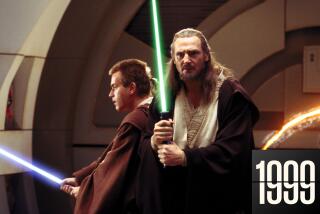‘Star Wars’ Creator Tests Force of Thinking
- Share via
For 15 years, while pondering plots for “Stars Wars” prequels, George Lucas has been nurturing another passion--games that teach kids to think, focusing on problem-solving skills rather than drill and the regurgitation of facts.
In September, he will release the first title under the Lucas Learning banner: “Star Works DroidWorks” ($39.95, https://www.lucaslearning.com) for ages 10 and up. Three more are scheduled for spring of 1999, around when the new “Star Wars” movie is scheduled to open.
“This is George’s passion,” said General Manager Susan Schilling at her office in Marin County. “He wants to create the kind of learning experience that he wishes he had access to when he was in school.”
Lucas Learning is making a plunge into a crammed and competitive educational software market, which generated more than half a billion dollars last year, according to PC Data Retail Software Report. The stakes are high as the small companies struggle and one of the biggies, Broderbund, was purchased by the Learning Company as recently as June.
But Schilling expresses no doubt there will be a demand for their products. Not only does she have the “Star Wars” theme to attract fans but, she points out, the number of thinking games in the market is relatively small.
But it’s growing. Along with such staples as “The Oregon Trail,” a new battery of educational computer games aims to teach kids the kind of critical thinking skills that colleges and employers have been calling for. Unlike programs such as “Math Blaster,” which rehearses players in math facts, the thinking games challenge children to create, plan and deduce.
A former creative director for MECC (also purchased by the Learning Company), Schilling is a veteran of thinking-game development, having worked on that company’s “The Amazon Trail” (now being re-released in its third edition, $29.95, https://www.learning.com) and “The Oregon Trail” (last year’s third edition, $49.95, now re-released on an even more interactive DVD-ROM).
Popular in schools, “The Amazon Trail” and “The Oregon Trail” ask players to plan a journey and experience the consequences of their choices.
And then there are companies such as Edmark and Humongous Entertainment, known primarily for thinking programs that focus on the younger set.
Edmark, famous for its “Thinking Things” series, has begun to reach out to older children with its new “Sky Island Mysteries” ($29.95) and “Zap!” ($30), both geared to ages 8-12. “Sky Island Mysteries” asks kids to solve 14 capers, using logic, sequencing and language to solve crimes. In “Zap!,” lightning has damaged the lighting, sound and electrical systems at the Wonder Dome theater. Players must fix the problems so the show can go on.
Humongous Entertainment remains wildly popular among children 3-8, who delight in the visually rich, emotionally complex animated worlds in which they use thinking and observation skills to help their favorite characters succeed. In its latest, “Pajama Sam: Thunder and Lightning Aren’t So Frightening” ($29.99, 800-499-8386), kids help Pajama Sam negotiate his way through the World Wide Weather factory to face his fear of thunder and lightning.
Teachers welcome these kind of programs. Ellie Director, who has taught grades K-5 and run a math and science lab during her 30-year teaching career with the Whisman School District in Mountain View, Calif., said that children like skill games “because they get an immediate response.”
But she said she prefers thinking games because “it exercises the brain. Children have to think through the problem and go through steps to reach a reasonable conclusion. This is the kind of thinking they’ll be facing all their adult lives.”
Still, the number of thinking games remains relatively small because, with the multiple choices offered, they are more complicated and, therefore, more expensive to design. Also, at Lucas Learning, Schilling said, Lucas simply didn’t feel the technology of the home computer was advanced enough to support his vision until now.
“Star Wars DroidWorks” opens as dramatically as a “Star Wars” movie. The familiar type blasts and recedes on a starry screen: “A long time ago in a galaxy far, far away . . . “
Except this time, the player is part of the story. To thwart the plans of the evil Emperor, the player must infiltrate a droid factory and reprogram the robots to perform a variety of different missions on three levels of difficulty, designing each droid from a choice of 88 parts--and at least 25 million permutations--with an eye to the specific demands of each task.
Players can name and paint their designs, using a holographic design grid for 360-degree viewing. If the robot’s specifications fit the requirements, the mission may succeed. If not, it’s back to the drawing board, to learn from mistakes.
And mistakes, Schilling noted, are an important part of the learning process.
“We’re offering an open environment where kids can explore,” she said. “We have a design philosophy which allows them to find multiple solutions and gives them a chance to learn from failures. Because in real life, that’s how most of us learn--from things that fail.”
More to Read
The biggest entertainment stories
Get our big stories about Hollywood, film, television, music, arts, culture and more right in your inbox as soon as they publish.
You may occasionally receive promotional content from the Los Angeles Times.










